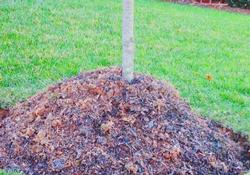Caring for Young Trees and Shrubs

Water
Water new plants frequently, especially during hot, dry weather. Wet the root ball directly; avoid ponding water around the trunk and avoid wetting the trunk.
Allow the soil surface to dry between waterings. Increase the interval between waterings as plants become established and encourage good root growth through less frequent, thorough, deep soakings.
Avoid frequent sprinkling that wets only the surface; this encourages undesirable shallow root growth and will not satisfy the plant's need for water.
Mulch

Piling mulch too high around the trunk, known as mulch volcanoes, can cause existing surface roots to suffocate and new roots to grow into the mulch instead of the soil. It can also soften the bark of young trees, making them more susceptible to insects and disease.
Feed
Fertilize woody plants sparingly during their first growing season. Nitrogen is usually the only nutrient to which woody plants respond. Use slow-release fertilizers; quick-release fertilizers can harm young roots and retard plant growth if applied too heavily.
Prune
Prune young woody plants during the first few years of growth to encourage good structure and remove damaged or diseased stems; establishing a central leader or dominant main terminal is important.
Avoid excessive pruning, which may retard growth. Remove weeds, turf, and groundcovers that grow near the trunk of young trees; they can seriously retard young woody plant growth.
Stake
Only stake a tree to protect or support the trunk or anchor the root ball during the first year or so after planting. Do not fasten trunks firmly; they must be allowed to flex some with the wind to develop stem strength.
Learn more about caring for trees and other plants.
